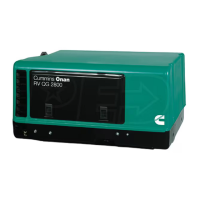Section
5.
Preparing
to
Service
TROUBLESHOOTING
.
Before starting
to
service the generator set, follow a
systematic troubleshooting procedure to locate and iso-
late the problem. For servicing purposes, the generator
set can be divided into the following:
0
Engine
-
Primary Systems
0
Control
0
Generator
Engine
-
Block Assembly
This manual contains separate sections that cover each
area.
Several troubleshooting guides are included in this
manual to help the serviceperson locate the cause of
various malfunctions. Note that some malfunctions
might have several possible causes. Forthis reason, the
serviceperson may have to investigate several likely
problem areas in order to isolate the source of the mal-
function. Because of the complexity of the product, a
troubleshooting chart cannot list every malfunction and
the cause. In some situations, the serviceperson will
have
to
rely on experience and a knowledge of the
product
to
locate the problem and service as required.
SPECIAL
TOOLS
The following special tools may be required
to
service
the generator set. Some
of
these
tools
may be pur-
chased from Onan whileothers may be purchased from
outside suppliers.
A
complete listing of the tools availa-
ble from Onan is contained in the Tool Catalog
(900-
0019)
which is available from Onan Dealers or
Distributors.
Engine
Tools
Torque wrench
(0-50
Ft-Lbs
or
0-70
Nom)
Feeler gauge
Pressure gauge
Spark plug gap gauge
Flywheel puller
Gear separator
Cylinder ridge reamer
Piston ring compressor
Piston ring spreader
Cylinder hone
Wire brush
Piston groove cleaner
Outside micrometer set
(0
to
4
in.)
Telescoping gauge set
(1
/2
in.
to
6
in.)
Hole gauge
(0.300
in. to
0.400
in.)
Valve Seal Replacement
Tool
4
Valve seat cutter
Generator and Control
Tools
Lead or dead-blow hammer
Battery hydrometer
VOM multi-tester
Frequency meter
Armature growler
Load test panel
Jumper wires
Fan hub assembly holding
tool
SAFETY
CONSIDERATIONS
Always consider the safety aspects of any service
procedure. Generator sets present several hazards that
the serviceperson must be aware of to safely complete
the job. Read through the safety precautions listed on
the inside cover and familiarize yourself with the various
hazards shown in Table
5-1.
Once the hazards are
known, approach the job with a safety conscious atti-
tude. Being safety conscious
is
the most effective way to
avoid injury
to
yourself or others. Reduce the chance
that an accident will occur by adopting the following
safeguards.
Safeguards
to
Avoid
Hazards
0
Use Personal Protection
-
Protect your body by
wearing the appropriate safety equipment. Protec-
tive clothing includes safety shoes, gloves, safety
glasses, and hard hats. Leave rings and jewelry off
and do not wear loose clothing that might get
caught on equipment.
0
Work to Reduce the Hazard
-
The workshop area
and all pieces of equipment used can contribute
to
reducing the hazard potential. Keep guards and
shields in place on machinery and maintain equip-
ment in good working condition. Store flammable
liquids in approved containers away from open
flame, spark, pilot light, cigarette, or other ignition
source. Keep the workshop clean and well-lighted,
and provide adequate ventilation. Keep fire extin-
guishers and safety equipment nearby and be pre-
pared
to
respond
lo
an emergency.
5-1

